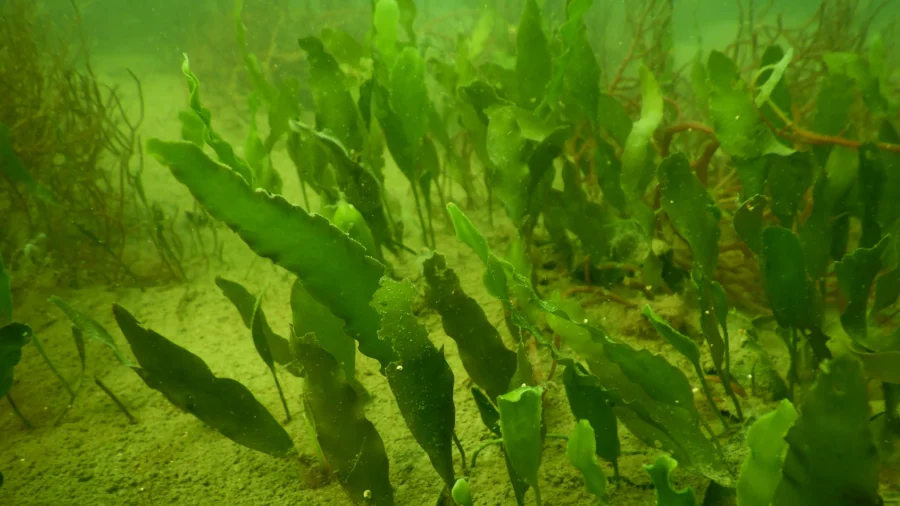The Port of San Diego is continuing its fight against an invasive species of algae in San Diego Bay. First discovered in the area in September, 2023, the Caulerpa prolifera algae is a major threat to marine flora and fauna.
In a press release, the Port said that additional patches of the species have been found in and around the Coronado Cays.
“Caulerpa prolifera is a type of tropical algae that grows and reproduces extremely quickly, choking out native seaweeds and seagrasses, potentially harming marine life through loss of habitat,” according to the release.
Of primary concern in the bay is the protection of eelgrass, as well as the fish, birds, and other marine life that are heavily reliant on eelgrass for food and shelter. Eelgrass is also a critical prerequisite for good water quality, as it is a natural water filter.
There are around 2,600 acres of eelgrass throughout San Diego Bay, 1,900 of which are in the South of the bay.
According to Frank Urtasun, chairman of the Port of San Diego Board of Port Commissioners, locating and removing every trace of Caulerpa is critical to preserve a healthy ecosystem in the bay, in addition to protecting jobs and tourism in the area.
“Caulerpa is also a potential threat to local jobs and businesses. In the 1980s, a Caulerpa outbreak in the Mediterranean Sea caused millions of dollars in losses to tourism and fishing industries because it was not contained. We will not let that happen in San Diego Bay,” he said in the release.
“With our many local, state, and federal partners, we are being swift and prudent to protect both our environment and our economic interests,” said Mr. Urtasun.

The algal species was first discovered by a group of divers in late September, who located a small patch of the plant during “an in-water pre-construction eelgrass/Caulerpa dive survey as a permit condition for a dock replacement project.”
Later surveys revealed additional patches in the vicinity of the Cays, with a total of over 11,000 square feet discovered. Measures have since been taken to kill off the algae by means of a sealed barrier that blocks it from light, oxygen, and tidal circulation.
The Port of San Diego said the infestation was likely due to the release of the contents of a saltwater aquarium into the bay.
Caulerpa is commonly used in saltwater aquariums. Because of the environmental risks, however, it is illegal in California to possess, sell, or transport any Caulerpa seaweed, with fines ranging from between $500 to $10,000 for each violation.
Those who have saltwater aquariums are instructed to avoid using, sharing, or selling Caulerpa, and to avoid dumping the algae into state waters, or into drainage facilities on the streets—as many of these drain water directly into watercourses and, ultimately, the ocean.
If necessary, it is recommended that aquariums are drained into sinks or toilets, as such water is normally piped to a water-treatment plant, thus minimizing the threat.
The spread of Caulerpa is exacerbated by contact with vessels and fishing. As a result, swimmers and those using boats and kayaks are asked to familiarize themselves with the algae and to avoid entering infested areas.
Anglers are advised to check their fishing gear for any residue of Caulerpa. However, the algae is not harmful to humans who come into contact with it.
The discovery of Caulerpa is the first of its kind in San Diego Bay. A previous infestation of Caulerpa was found in 2021 in Newport Bay, with eradication and monitoring efforts ongoing, according to the NOAA.
Other species of Caulerpa were discovered in Huntington Harbor and Agua Hedionda Lagoon in Carlsbad further up the California coast in the early 2000s, which led to routine monitoring by Port authorities since.
Port authorities have been committed to controlling the algae in affected areas by working closely with the Southern California Caulerpa Action Team (SCCAT), and by applying any treatments necessary to secure the eradication of the species and to prevent further infestation.
Anyone noticing or identifying the species in any location in California is urged to visit the website wildlife.ca.gov/Conservation/Invasives/Species/Caulerpa, where they can find more information and submit a report, if necessary.

